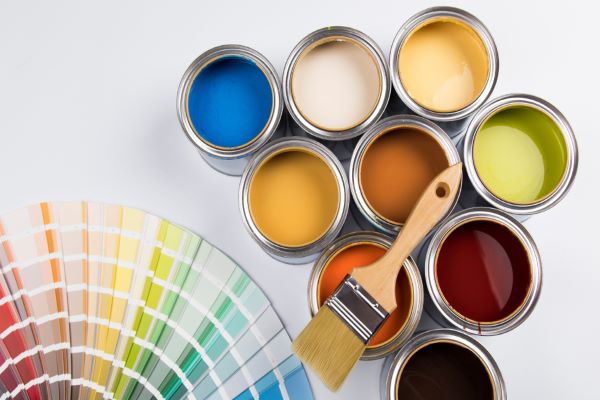Over the next 3-4 years, the industry is expected to augment its capacity by 20% of the current levels

The Indian paint industry is dominated by organised players, constituting approximately 70% of the total market share. As of the end of FY23, the organised market is valued at Rs 62,000 crore. Within this domain, the top five industry leaders, namely Asian Paints, Berger Paints, Kansai Nerolac Paints, Akzo Nobel, and Indigo Paints, command a substantial 90% market share.
In terms of consumption, decorative paints hold a majority share, contributing to about 70% of the market, while industrial paints account for the remaining 30%. Demand dynamics are largely shaped by the real estate sector, which commands approximately 70% of the total market demand. The remaining demand emanates from diverse sectors including automotive, oil and gas, aerospace, and marine, among others.
Sales Growth of Top Players Likely to Moderate
The top five industry players have demonstrated remarkable growth, registering a robust Compound Annual Growth Rate (CAGR) of 14-15% over the past five years (FY19-FY23). This growth trajectory notably accelerated during FY22 and FY23 aided by recovery in demand from key user industries, which rebounded after the initial pandemic-induced setback. Historically, the demand for paints tends to expand at a rate 1.5 to 2 times higher than the GDP growth rate. However, this robust growth is expected to temper in FY24. As per CareEdge Ratings, the sales of the
Softening Raw Material Prices Expected to Help in Margin Expansion in FY24
The prices of raw materials account for 50-60% of total sales. The key raw materials used in paint manufacturing are titanium dioxide, phthalic anhydride, solvents, pigments, resins, and other crude oil derivatives. The prices of key raw materials have remained elevated during FY22 and FY23 on account of supply-related disruptions during the pandemic and then the Russia-Ukraine war in turn impacting crude oil prices. However, prices of raw materials have started cooling from the second half of FY23.
Prices of titanium dioxide, which contributes around 55-60% of the total cost of raw materials, declined by 30% y-o-y in the March-June 2023 quarter. The prices of other key raw materials are also dependent on crude oil. With a decline in the price of crude, the prices of other raw materials have also softened. Players across the industry took price hikes of 15–20% in FY23 and around 2.5% in Q1FY24. With the prices of paints staying firm and input costs softening, the industry is expected to witness an expansion in profit margins in FY24 in the range of 100 to 200 bps.
Competitive Intensity Expected to Increase in Long Term
In recent years, the paint industry has seen the entry of several new business conglomerates, including Grasim Industries, Pidilite, and the JSW Group, who have joined the competitive landscape, challenging the established players. These newcomers are well-endowed industrial giants with a robust financial footing. Nevertheless, it is anticipated that they will require a significant period, estimated at five to seven years, to establish their presence in the market and secure a meaningful market share from the established industry leaders.
Success in the paint industry hinges on two pivotal factors: distribution and expenditures on marketing and advertising. In terms of distribution and market outreach, the top five industry players possess a substantial dealer network spanning the entire country. Achieving parity with them in this regard will demand substantial time and investment from the new entrants. In the realm of marketing and advertising, prominent players such as Asian Paints allocate approximately 5% of their sales budget towards advertising, given their substantial sales figures. In contrast, Nippon and JSW Paints, as well as Indigo Paints, allocate a more pronounced 15-20% of their sales budget towards advertising efforts.
Demand from Key End-user Industries to Support Growth
The real estate sector accounts for about 70% of the total paint demand. The demand from real estate is expected to be robust in FY24 on expectation of significant project completion, and increased government spending on affordable housing and infrastructure. As per CareEdge Ratings estimates, residential housing sales are expected to increase by 10% in the top fifteen cities during CY2024. Demand for decorative paints increases due to a rise in both repainting activities and housing sales. Traditionally, about 20% of the demand for decorative paints comes from new construction.
Demand from repainting, which accounts for 80% of total decorative paint demand, is also expected to pick up due to factors such as a growing population, an increase in rental homes and growth in the income levels of consumers. Furthermore, the repainting cycle has reduced as consumers have started to paint their houses at frequent intervals. Industrial paints account for about 30% of the total paint demand. This demand comes from industries like automotive, oil and gas, aerospace, marine and electronics. The majority of the industrial paint demand is derived from the automotive industry which is expected to post significant growth in FY24.
Capex Planned in Next 3 to 4 Years to Increase Competitive Intensity
The capacity of the top five players is pegged at around 4.22 Mn KL per annum as of the end of FY23. The industry has a planned capex of Rs 20,000-22,000 crore over the next three to four years with Rs. 10,000 crore planned by Grasim Industries and Rs 8,750 crore by Asian Paints. This is expected to increase the overall capacity by 20% in turn increasing the competitive intensity and restricting the margins for top players over the long term.
Yogesh Shah, Senior Director, CareEdge Ratings, said, “Housing sector growth and demand for repainting amid growing aspirations among people will be the major growth drivers for decorative paints. On the supply side, the industry is expected to augment capacity by 20% in the next three to four years, driven by the capex undertaken by the new and existing players. Hence, the competitive intensity is poised to escalate in the long haul.”
Subscribe to our newsletter & stay updated.